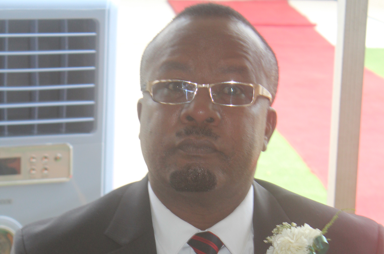By Tileni Mongudhi | 18 December 2015
THE company chosen for a multibillion-dollar contract to fix Namibia’s looming electricity crisis failed to meet basic set requirements. The Namibian has seen evaluation documents suggesting that the state energy company, NamPower (Namibia Power Corporation), overlooked its own criteria to allow Xaris several opportunities to fine-tune its bid.
Among crucial requirements that Xaris failed to provide at the first hurdle of the tender are the power plant’s generation capacity, financial information, and an approved environmental impact assessment.
Xaris chairman Boni Paulino, however, denied the claims, saying they had met the criteria.
NamPower awarded Xaris the contract to build a 250MW power plant, after having called for proposals for the construction of a power plant to solve the country’s short-term electricity needs while waiting to build the Kudu gas-to-power plant.
It was first concluded that the bidder’s financial information and technical bid was “indistinct”, so much so that evaluators had to request for more details.
Part of the tender conditions was that if the bidder offers more than 250 megawatts generation capacity, they would be disqualified. The evaluation documents indicate that Xaris’ bid was for 300MW with a six gas turbine power plant. It is believed the power plant Xaris wants to build cannot offer less than 300MW.
After it was discovered that they could be disqualified from the process, Xaris then changed their bid while the evaluation process was in progress.
“Xaris has also offered a compliant 250MW scheme using five gas turbines, with a reduction of US$25 million in the capital cost,” read the evaluation documents seen by The Namibian. This meant Xaris had to move away from its original bid to meet tender requirements.
Another area in which Xaris was not compliant was the environmental impact assessment (EIA). An approved EIA was a significant part of the first stage of tender conditions because without approval of the environmental commissioner and other state agencies, the project would not get off the ground.
An EIA investigates the project’s impact on the environment, human health, culture and socio-economic impacts of the area in which the project is supposed to be implemented.
Information at The Namibian’s disposal indicates that NamPower decided to push for Xaris as the favourite or “preferred bidder”, despite not meeting crucial requirements such as having an EIA certificate.
For instance, Xaris was still working on their EIA in March this year, long after the NamPower board of directors awarded them the “preferred bidder” status in September last year.
KPMG’s evaluation report ticked off Xaris as having submitted or being in compliance with the EIA requirement at the time when the report was not done.
The tender requirements were considered so strict that three of the six shortlisted bidders pulled out, convinced that they would not meet the conditions. The three bidders decided to forego an opportunity to make presentations as they believed NamPower would not give them enough time to state their case.
Paulino disputed these claims and said that the EIA certificate was only a requirement after Xaris achieved preferred bidder status and said everything in the process was done above board. He added that Xaris’ EIA application was submitted with the environment ministry but was put on hold since the tender was also suspended.
One element of the deadline was the “financial close” requirement, which was set for January 2015. Financial close means that by the set date the preferred bidder must have everything in place and be ready to commence construction of the power plant, which was supposed to be going online by July 2016. A company that did not have an approved EIA by February could not have met the “financial close” deadline, which in turn would postpone the date the power plant goes online.
This information shines the spotlight on the integrity of the tender process which is becoming more tainted, while suggesting the tender might have been fixed.
The Namibian was unable to get clarity from NamPower over the issue. Calls to several senior officials including the chief officer of power systems development, Reiner Jagau, proved futile. Jagau said he was not at liberty to discuss the Xaris project with the media. He then referred questions to acting CEO Simson Haulofu. Haulofu could not be reached.
EVIDENCE SO FAR
KPMG, a reputable international auditing firm, was appointed to evaluate the process of awarding the 250MW power generation tender. The Namibian has reported that KPMG was appointed on a fixed contract of N$2,4 million but the utility ended up paying N$36 million for KPMG’s services. There has been no explanation why the cost was inflated 16 times.
The KPMG transaction led to the suspension of NamPower managing director Paulinus Shilamba, NamPower’s chief technical services officer O’Brien Hekandjo and senior manager for energy trading Werner Graupe in July this year.
The tender adjudication documents indicate that Graupe and Hekandjo are the only two NamPower officials who worked with KPMG officials in the evaluation process. The other firm involved in the evaluation process was Mott MacDonald, an international consultancy company. It was responsible for evaluating the technical part of the bids.
Also interesting is the fact that KPMG’s team leader in the process, Kalipa Mtati, left KPMG after The Namibian reported about the malfeasance.
Questions are now being asked whether KPMG was being rewarded for manipulating the tender results.
The Namibian first indicated something untoward about the tender process in July last year, when it reported that NamPower chairperson Maria Nakale failed to declare a connection to Xaris Energy director Boni Paulino, her superior at the Namibia Financial Institutions Supervisory Authority (Namfisa).
Apart from being colleagues at Namfisa, Nakale and Paulino are also said to be friends although she, as a general manager for provident institutions, does not report to Paulino, who is an assistant chief executive for support services at Namfisa. Both Nakale and Paulino denied being friends at the time. Nakale allegedly also refused to recuse herself from the process when asked by fellow NamPower directors to do so.
Nakale’s fellow NamPower directors pointed out that her conflict of interest became apparent when she adamantly insisted that the tender award goes ahead even when mines minister Obeth Kandjoze, supported by the Electricity Control Board (ECB), had raised red flags and wanted the tender award relooked. Nakale had allegedly undermined Kandjoze, her appointing authority, to the point where Kandjoze asked President Hage Geingob to intervene.
Geingob then put the project on ice in May this year amid allegations that Xaris had changed the tender’s original terms of reference and wanted to increase their generation capacity from 250 MW to 400MW, meaning the project cost would also go up from the planned N$3 billion to N$7,6 billion.
The Namibian at the time also reported that ECB chief executive Foibe Namene was allegedly receiving death threats because she was trying to block the Xaris deal, which the ECB felt was not in the country’s interest. Namene had denied the claims at the time.
President Geingob on Monday told a media conference that he stopped the tender because the government was footing the bill for the project but was later informed that Xaris would pay for the project.
The Namibian has learned that there are components of the Xaris power plant that would depend on government funding.
* This story was produced by The Namibian’s investigative unit.






